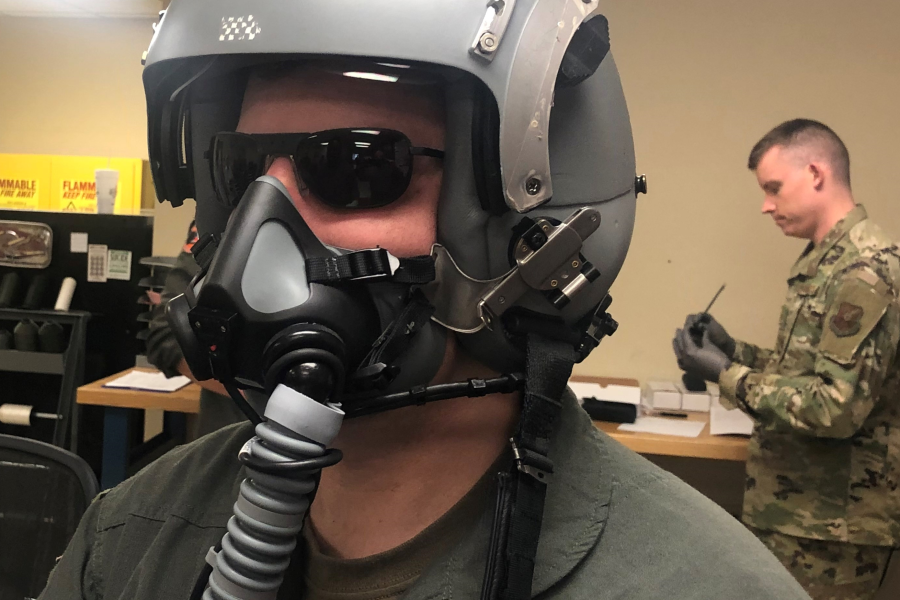Most drivers know the feeling: You’re on the road at night, when a car driving in the opposite direction comes around a bend and hits you with the high beam headlights. Suddenly, the contours of the road and practically everything else can be hard to make out.
For Air Force pilots, the threat can be even greater. Whether it’s civilians pointing commercial laser pointers in the sky or adversaries training military-grade laser weapons on aircraft cockpits, USAF aviators face eye damage and potentially fatal distraction.
“Even lasers that you can buy off the shelf at a Party Supply Store can cause serious damage, especially if there’s a situation where a pilot comes in to land and he’s distracted—even if it’s not damaging to the eyeball,” said 2nd Lt. Nicholas Zjad, of the Air Force Life Cycle Management Center’s human systems division. “The amount of distraction that even a cheap red laser could create could have very serious consequences.”
To counter these threats, Zjad and other members of the Aircrew Laser Eye Protection Program are rolling out “Block 3” of the Air Force’s protective eyewear.
Block 3 includes eight new devices, from spectacles that protect against lasers and/or ballistic threats om both day and night, to visors and night vision goggles. All told, program leaders estimate USAF will acquire some 42,000 pieces of equipment delivered throughout the rest of the 2020s. Established as a program of record in 2017, Block 3 has already started to deliver daytime sunglasses and night vision goggles with laser eye protection, Zjad said.
Instances of “lazing”—laser pointers being shined at aircraft pilots—have surged in recent years, according to the Federal Aviation Administration and the Air Force Office of Special Investigations. In 2022 alone, there were 9,500 incidents nationwide.
“These are not harmless pranks. There’s a risk of causing permanent visual impairment,” said an OSI official in an October release. “From the public’s standpoint, misusing lasers can severely impact a person’s ability to see and function.”
Military threats are also on the rise. The Philippines accused a Chinese coast guard ship of using a military-grade laser to temporarily blind the crew of a Philippine ship earlier this year. In 2022, Australia said a Chinese naval vessel shined a laser at an Australian P-8. The U.S. Air Force pilots has also accused China of using lasers against Airmen in the past.
“We work closely with the intelligence community to ascertain the current laser threat, and this is an ever-evolving issue,” Zjad said. “The laser threat space is continuous and it gets more and more intricate. So we rely on that data and put that into our requirements. We also take user requirements from previous blocks and implement that. So we want to do what’s right by the user and we want to make sure that the user has the comfort and the protection that they need to safely and effectively operate aircraft.”
In such instances, your average gas station sunglasses won’t cut it.
“We really are in the high-end sunglasses industry,” Mark Beer, Aircrew Laser Eye Protection Program deputy program manager, told Air & Space Forces Magazine. “So wherever there’s a defined threat, to get the protection, we put in more dyes. Your regular sunglasses, they have a low amount of dye just to darken it and prevent the visible light from coming in. So wherever there is a threat laser, then we just put in dyes to block those photons coming from that device.”
At the same time, the program is also working on nighttime glasses that can let more visible light in while still offering laser protection.
“In the past, there were some very cool technologies used to manufacture them and provide the protection levels, but it was also very, very costly,” Beer said. The Air Force wants to make it easier to get the protection. “So we’ve been primarily focusing on cheaper methods of production as well as adapting the technologies to larger curved surfaces. So your spectacles are kind of small and they’re easy to produce, but if you have a wrap-around style like sports sunglasses, it’s larger and more complex.”
On top of that, the program introduced ballistic protection on top of laser protection in Block 3, a new requirement.
“We were able to introduce some technologies into the larger curved surface of wraparound sunglasses, that made the ballistic spectacle an option, so we just started testing it to that and they passed,” Beer said.
While previous laser protection eyewear was impact-resistant, ballistic protection will ensure glasses won’t shatter when struck by small arms fire or shrapnel, concerns that especially matter to helicopter pilots and others who fly close to the ground.
Block 3 eyewear will be available to all aircrew except for those using the F-35 or U-2—and could be crucial to keeping aircraft flying in the years to come.
“There are only a certain small number of people that can do optical quality injection molding and the dyes and some of the other technologies that they work with to try to make things cheaper, lighter, work better, more comfortable to the aircrew,” Beer said. “It’s really a community effort.”
